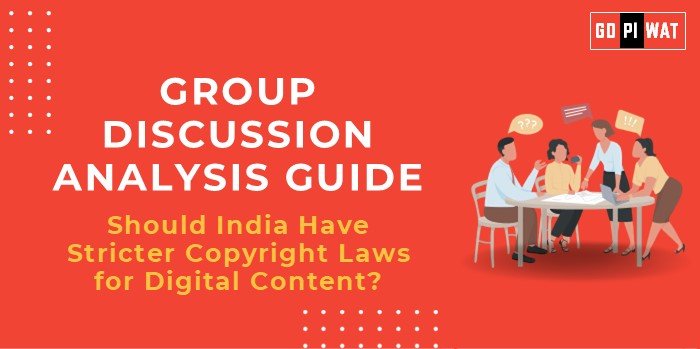📋 Group Discussion Analysis Guide: Should India Have Stricter Copyright Laws for Digital Content?
🌐 Introduction to the Topic
- 📜 Opening Context: “As India’s digital economy grows exponentially, copyright protection for digital content has become a critical issue, balancing innovation and creativity against piracy and accessibility.”
- 📖 Topic Background: The current copyright framework under the Indian Copyright Act, 1957, has undergone amendments, yet it lags behind the fast-evolving challenges of the digital world. Stricter laws could safeguard creators but may also impact digital accessibility and innovation.
📊 Quick Facts and Key Statistics
- 🌐 India’s Digital Economy: Valued at $1 trillion by 2025 (NASSCOM) – emphasizes the need for robust copyright mechanisms.
- 📈 Piracy Prevalence: India ranked 6th globally for online piracy in 2022 (Musso Report).
- 🎥 Content Industry Value: OTT and digital content worth $2.5 billion annually (FICCI).
- ⚖️ Legal Framework: Last major copyright amendment in 2012.
- 📶 Internet Penetration: 900 million users, with a vast young population driving content consumption.
👥 Stakeholders and Their Roles
- 🎨 Content Creators: Demand robust laws to protect intellectual property and ensure fair compensation.
- 📱 Digital Platforms: Advocate for balanced policies that do not restrict user-generated content.
- 🏛️ Government: Responsible for legislating and enforcing copyright laws.
- 👥 Consumers: Seek affordable access without infringement risks.
- 🌍 International Organizations: Encourage compliance with global IP treaties (e.g., WIPO).
🏆 Achievements and Challenges
✨ Achievements
- 🎬 Rise of OTT Platforms: Driving content creation (Disney+ Hotstar, Netflix).
- 📚 Fair Use Doctrines: Adopted in education and research.
- ⚖️ Anti-Piracy Initiatives: Efforts like the Digital Copyright Protection Cell.
⚠️ Challenges
- 📉 High Piracy Rates: Impacting revenues.
- 🌍 Jurisdictional Complexities: Difficulty in enforcing digital copyright laws.
- ⚖️ Balancing Consumer Rights: Navigating between protectionism and accessibility.
Global Comparisons:
• USA: DMCA sets global benchmarks but faces criticism for stifling fair use.
• South Korea: Effective anti-piracy measures contribute to the growth of K-content globally.
Case Study:
• AIIMS Cyber Attack (2022): Raised concerns about the vulnerability of digital assets in India.
📢 Structured Arguments for Discussion
- 💬 Supporting Stance: “Stricter copyright laws will attract global investments in India’s content industries and provide fair incentives to creators.”
- 🗣️ Opposing Stance: “Overly strict laws may stifle innovation and disproportionately impact small creators and educational accessibility.”
- ⚖️ Balanced Perspective: “Stronger laws should coexist with frameworks that promote fair use, ensuring innovation and accessibility.”
📈 Effective Discussion Approaches
- 💡 Opening Approaches:
- Start with data: “India’s $2.5 billion OTT industry suffers annual losses of $200 million due to piracy.”
- Contrast viewpoint: “While stricter laws may safeguard creators, they risk limiting creative freedom.”
- 💡 Counter-Argument Handling:
- “Addressing piracy should focus on awareness and affordable access rather than just punitive measures.”
📊 SWOT Analysis
Strengths
- 📈 Growing digital economy.
- 🎨 Rich creative industries.
Weaknesses
- 📜 Outdated copyright laws.
- ⚠️ High piracy rates.
Opportunities
- 🌍 Global leadership in content creation with robust laws.
- 🤝 Potential partnerships with global content platforms.
Threats
- ❌ Over-regulation harming innovation.
- 📉 Loss of accessibility for marginalized groups.
🎓 Connecting with B-School Applications
- 💡 Real-World Applications:
- Study impact on startups in digital media and global copyright trends.
- 💡 Sample Interview Questions:
- “How can India balance copyright protection and digital innovation?”
- “Evaluate the role of international treaties in shaping India’s copyright laws.”
- 💡 Insights for Students:
- Focus on case studies of content-driven startups like TVF and AIB for deeper insights.
- Analyze the balance between monetization and accessibility in digital content markets.


